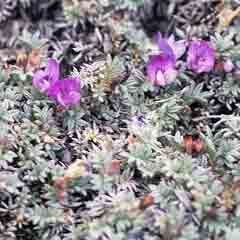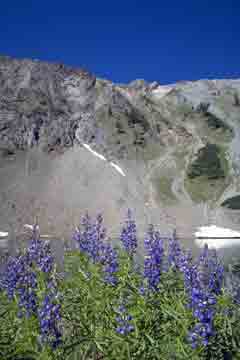
Silver lupine, Lupinus argenteus Pursh var. depressus (Rydb.) C. L. Hitchc. (left, right). Although the silver (or silvery) lupine is found in most states west of the Mississippi River, the variety shown here is restricted to the mountains of Idaho, Montana and Wyoming. It seldom grows more than a foot high and is quite at home at high elevations where alpine meadows are often covered with its bright flowers. It may be identified by this growth preference and by its crowded clusters of purple to blue flowers. Both flowering and fruiting plants, the latter with their typical pea-like pods, are shown on the right Recently, some have classified var. depressus as its own species, Lupinus depressus (the species name means “low”). The Lewis and Clark expedition returned a specimen of Lupinus argenteus var. argenteus, collected in Montana, on July 7, 1806.
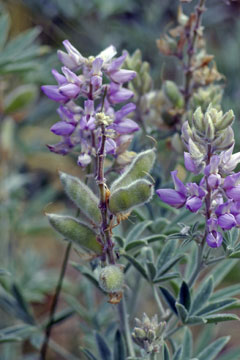
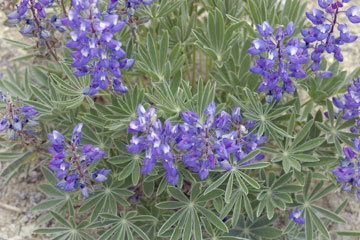
It can be difficult to distinguish between Lupinus argenteus and Lupinus sericeus. The flower clusters of the latter tend to be looser and are lower, extending well into the plant’s leaves; its indvidual flowers tend to be smaller. The banners are often lighter or partially white, its calyces have a hump on the dorsal surface, and the leaflets tend to be less pointed at the ends. Finally, as noted, Lupinus argenteus grows to higher elevations.

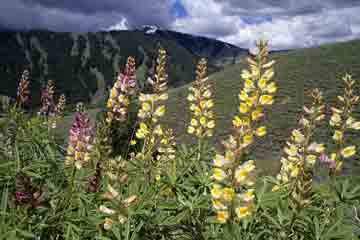

Longspur lupine, Lupinus arbustus Douglas ex Lindl. var. calcaratus (Kellogg) S. L. Welsh (left & above). This plant, formerly classified as Lupinus calcaratus has recently been reclassified; (arbustus means “small tree, or shrub” and calcaratus means “spurred” for a bump-like projection that extends backward from the top of the calyx). It is common in the Rocky Mountains and west to the coast, often growing in amazing profusion on sagebrush slopes as high as the subalpine zone. The color of the flowers varies considerably, from light purple to yellow—those shown here are typical.
Stemless dwarf lupine, Lupinus lepidus Douglas ex Lindl. var. utahensis (S. Watson) C. L. Hitchc. (right). This little lupine grows in the grass of montane meadows. Its flowers have short stems and the leaves, stems and base of the flowers are covered with long hairs giving the plant a furry, grayish appearance that serves to identify it.
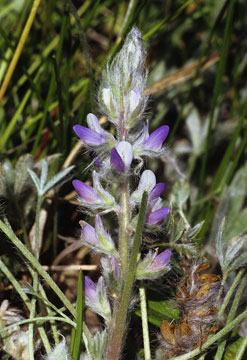
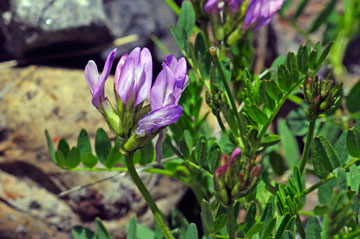
Alpine milk-vetch, Astagalus alpinus Douglas ex G. Don (right). Despite its name, the alpine milk-vetch grows also at lower altitudes. Its distribution in the States is much the same as the rather similar purple milk-vetch (left), although it is a circumboreal plant that grows in all of the Canadian provinces, Greenland and Eurasia. Both plants are commonly encountered in Idaho. The alpine-milk-vetch's leaflets are smaller and rounder, and its pod is long and darkly pigmented than those of the purple milk-vetch.
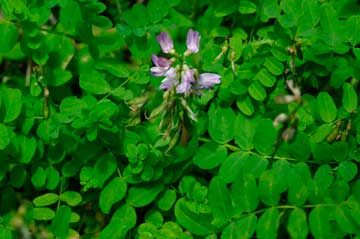

Pursh’s milk-vetch, Astragalus purshii Douglas ex Hook. (left). Astragalus purshii, grows as high as the montane zone. There are many varietal forms (the one shown here is var. concinnus). All have a prominent calyx and their flowers range in color from white through yellow to a purple-tinged pink, as in this illustration. The species name honors Frederick Pursh (1774-1820), the botanist who identified and published descriptions of many of the plants that Lewis and Clark collected.
Canadian milk-vetch, Astragalus canadensis L. var. mortonii (Nutt.) S. Watson (right). The Canadian milk-vetch grows from sea level to as high as the montane zone in our mountains. The variety shown here is found only in Idaho, Washington, Montana and British Columbia. The plants spread by rhizomes to form circumscribed patches. They have upright stems, clusters of yellowish-white pea-like flowers and, in our variety, a calyx covered with black and white hairs. This variety, var. mortonii, was gathered by Nathaniel Wyeth in 1833 and named to honor Philadelphia naturalist Samuel George Morton (1799-1851). Another variety, var brevidens (Gandog.) Barneby has much the same appearence except that it is a lower, more sprawling plant found often in moist situations. It's distribution is less restricted for it grows also in California, Nevada, Utah, Wyoming and Colorado.
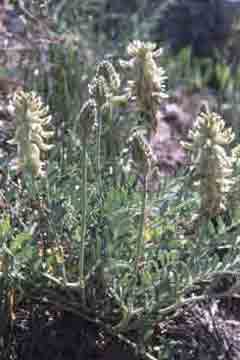
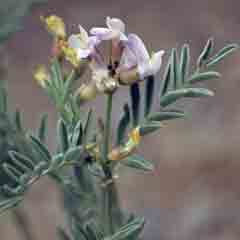
Bent-flowered milk-vetch, Astragalus vexilliflexus Sheldon var. nubilus Barneby (left). The bent-flowered milk-vetch is a tiny-leaved, small-flowered, densely matted plant that stands only an inch or so high. Although the species is found in the Rocky Mountains from Alberta to Wyoming, the varietyshown here, occurs only in central Idaho’s Custer County. (This plant was photographed well above treeline on Mt. Borah in the Lost River Range.) The species name, vexilliflexus, means, roughly “flexed standard,” referring to the banner. The varietal name, nubilus, means grayish-blue, for the leaves.
